- Site Collector Overview
- Get Started with Site Collectors
- Install Site Collector
- Set Up Collectors
- Sign Up for the Early Access Program: Site Collectors
- Choose the Right Collector based on Data Sources
- Set Up Archive Windows Collector
- Set Up Archive Linux Collector
- Set Up EStreamer Collector
- Set Up Fortinet Collector
- Set Up IBM Security QRadar Collector
- Set Up Kafka Collector
- Set Up Splunk Collector
- Set Up Linux File Collector
- Set Up Microsoft SQL Collector
- Set Up MySQL Collector
- Set Up Oracle Collector
- Set Up Syslog Collector
- Set Up Windows Active Directory Collector
- Set Up Windows Event Log Collector
- Set Up Windows File Collector
- Manage Site Collectors
- Apply Antivirus Exclusions
- Migrate to the New-Scale Site Collectors Service
- Modify Collector Configuration
- Modify a Site Collector Instance
- Manage Templates
- Monitor Log Sources
- Add Filters to Set Egress Log Filtering Conditions
- New Site Collector Management Service NGSCD
- Regenerate Certificates for Collectors
- Upgrade the Site Collector
- Upgrade the Site Collector Specifications
- Site Collector Monitoring
- Troubleshoot the Site Collector
- Pre-checks failed during Site Collector installation and upgrade
- Site Collector UI shows the status INSTALLATION_ERROR
- Download Support Packages for Troubleshooting
- How to reboot the Virtual Machine (VM) successfully to apply security updates?
- What information must be added while creating a support ticket to resolve an issue?
- Site Collector UI is not displaying the heartbeats
- Splunk Collector can't be set up
- Splunk Collector is set up however, logs are not reaching DL/AA
- Only a few of the installed Splunk Collectors are processing logs or EPS has dropped by 50% as compared to last hour
- The Windows Active Directory Collector (formerly known as LDAP Collector) is set up, however, the context data is not reaching DL/AA
- The Windows Active Directory Collector (formerly known as LDAP Collector) is stuck in the ‘Update’ mode after deployment
- Installation is initiated; however, the collector shows the status as ‘Setting Up’ for some time
- Data Lake and Advanced Analytics Does Not Show Context Data
- Context Data from Windows Active Directory Collector is Segmented
- Minifi Permission Denied - Logback.xml File Missing and Config File Update - Failed Error Occurred while Installing the Windows Event Log Collector
- Where should I upload proxy certificates if I am running proxy with TLS interception?
- How to upgrade Linux collector instance?
Set up GCP VM for Site Collector Installation
To set up the GCP virtual machine (VM) on which you want to install Site Collector, perform the following workflow:
Create the VM Instance
Prepare the GCP VM for installation.
Complete the environment requirements and prerequisites.
Create the VM.
To create the VM you will choose the appropriate GCP project, and begin the configuration of a new instance.
Log in to the Google Cloud Platform (GCP) console with your registered credentials.
On the top left corner, from the Select a project list, select the GCP project for which you want to create your new VM for Site Collector installation.

In this example, the selected project is NGSC Experiments.
Navigate to Compute Engine in the left pane and go to VM instances. Or navigate to VM instances by accessing https://console.cloud.google.com/compute/instances.
Click Create Instance.
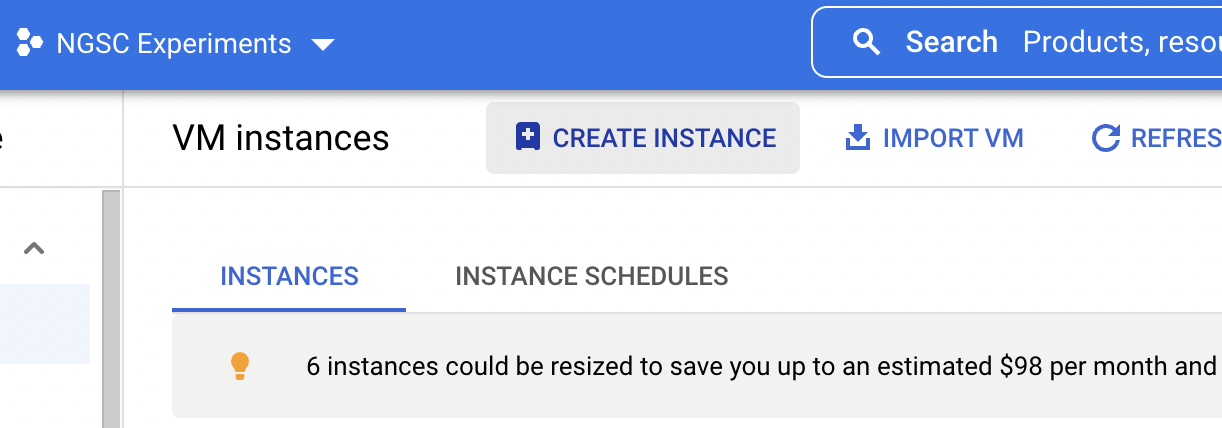
On the Create Instance page, enter the following information.

Name – Enter a name for your VM.
Region – Select the region and the associated zone.
– Select the machine configuration details. For example, 4 vCPU, and 16 GB memory
Configure the operating system and disk setup.
In the Boot Disk section, click Change and select the following configuration options.
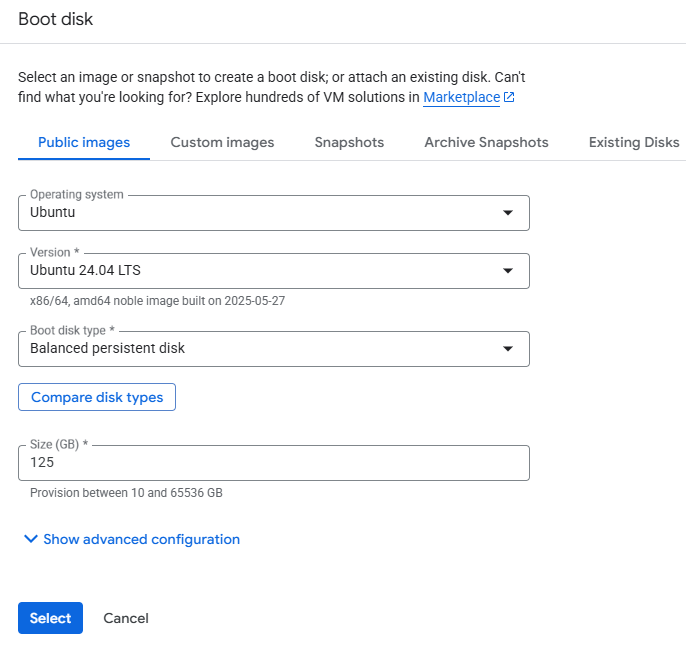
Operating System – Select the relevant operating system. For example, RHEL, or Ubuntu.
Version – Select the version of the operating system. For example, Ubuntu 24.04 LTS.
Boot disk type – Select the disk type. For example, Standard persistent disk or SSD disk.
Size – Select the disk size.
Configure advanced configuration options for networking.
Click Show Advanced Configuration > Networking.
To open the ports for internal communication, add network tags in Advanced options. Make the network ports mentioned in the prerequisites accessible.
In the Network Interfaces section, select a shared network interface; for example, platform-shared-vpc-us-west1. If the list of shared subnetworks is not available as a selection, contact your support team.
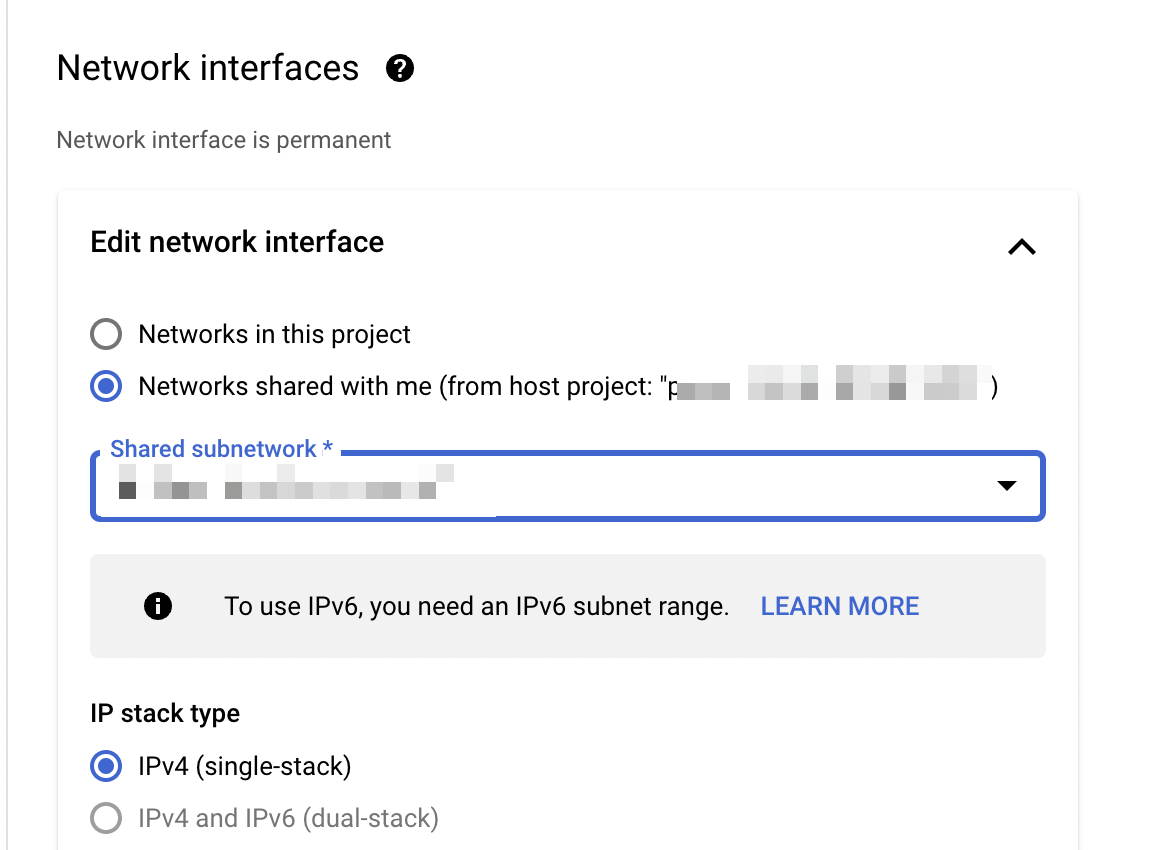
Allocate additional storage for Site Collector.
In the Disks section, add the following disks required for Site Collector installation. Refer to Site Collector Specifications for minimum storage requirements.
Note
For each new disk, ensure the following:
The disk name contains the VM name and partition name.
You must set the Deletion rule as Delete disk.

/content_repository(NiFi content repo partition)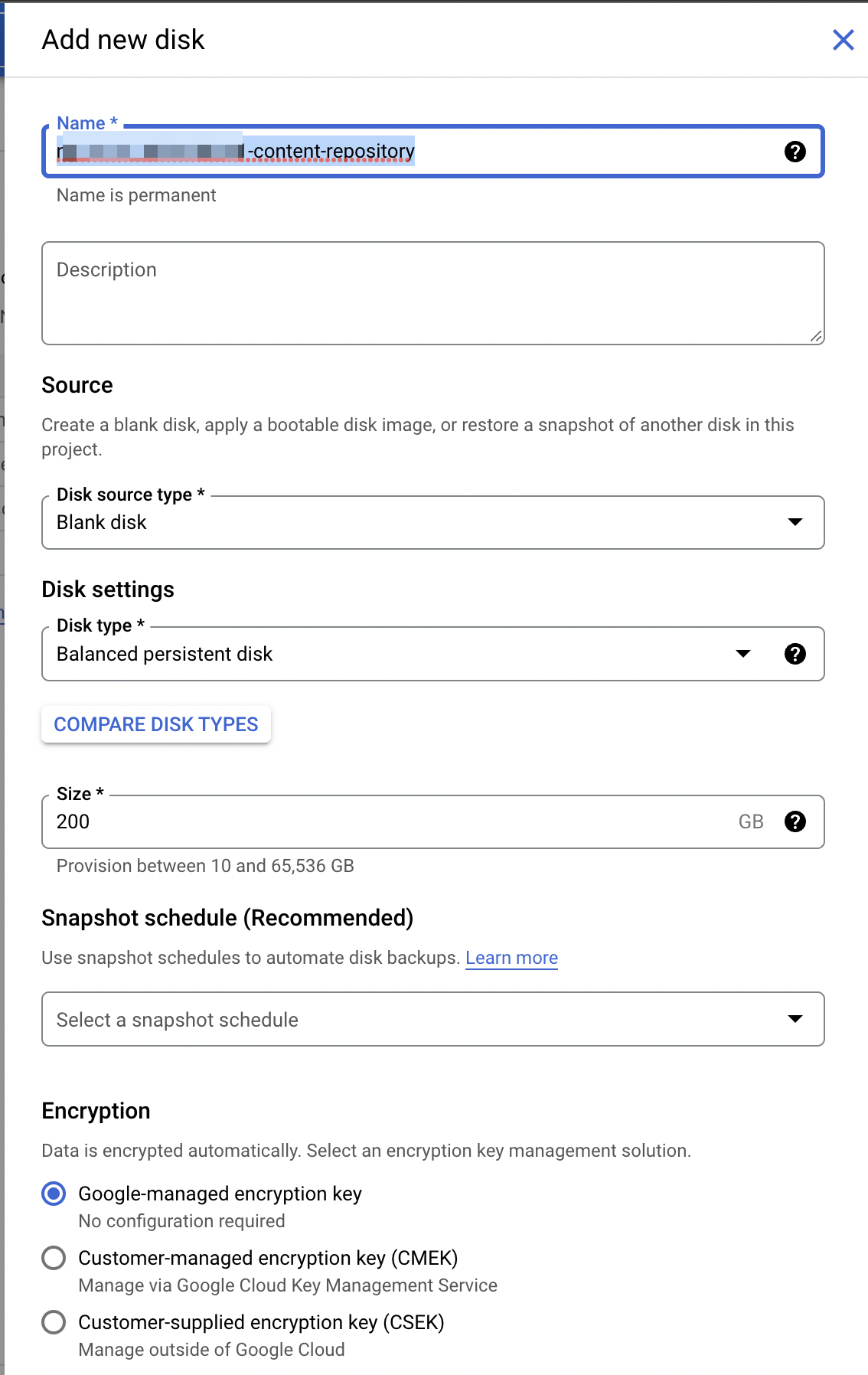
/provenance_repository(NiFi provenance repo partition)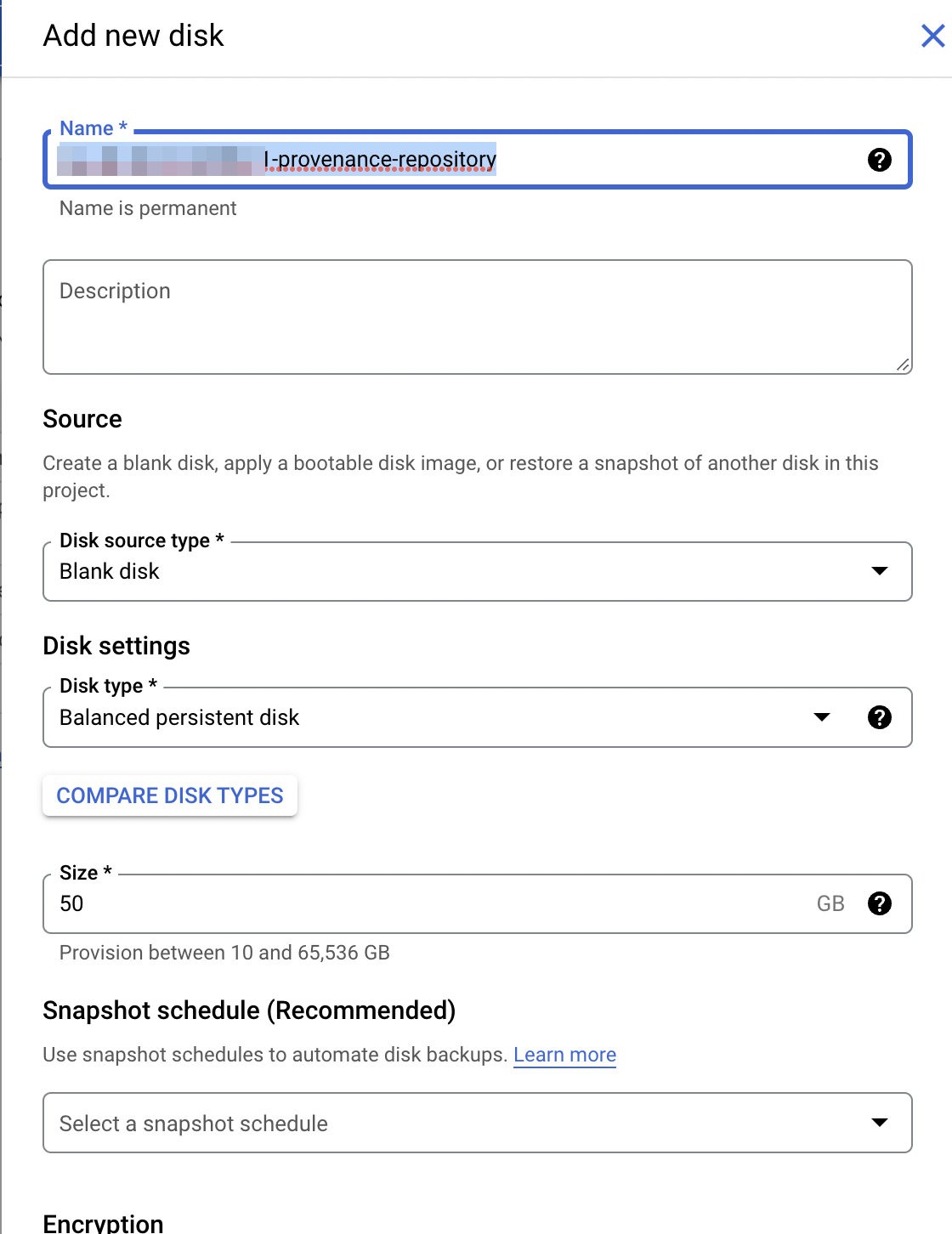
/flowfile_repository(NiFi flowfile repo partition)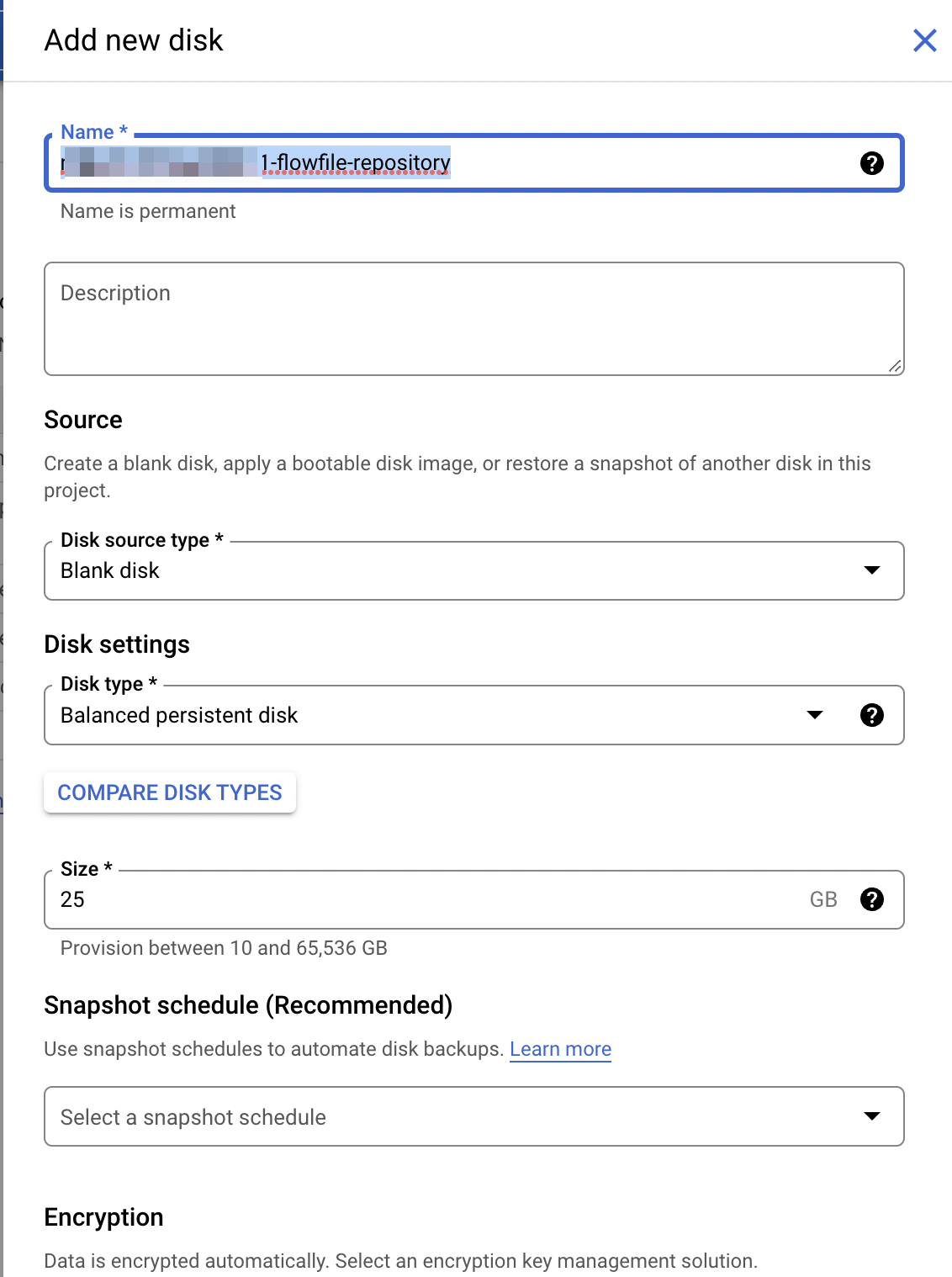
The Disks section displays the disks that you added.
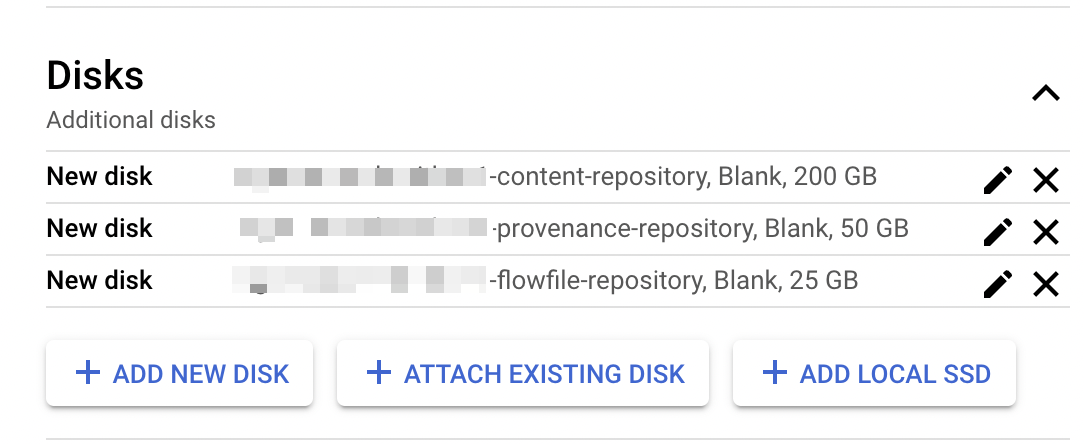
Configure SSH keys for secure access to the VM.
Copy the SSH key from the SSH Keys section.

Paste the SSH key in the Security section.
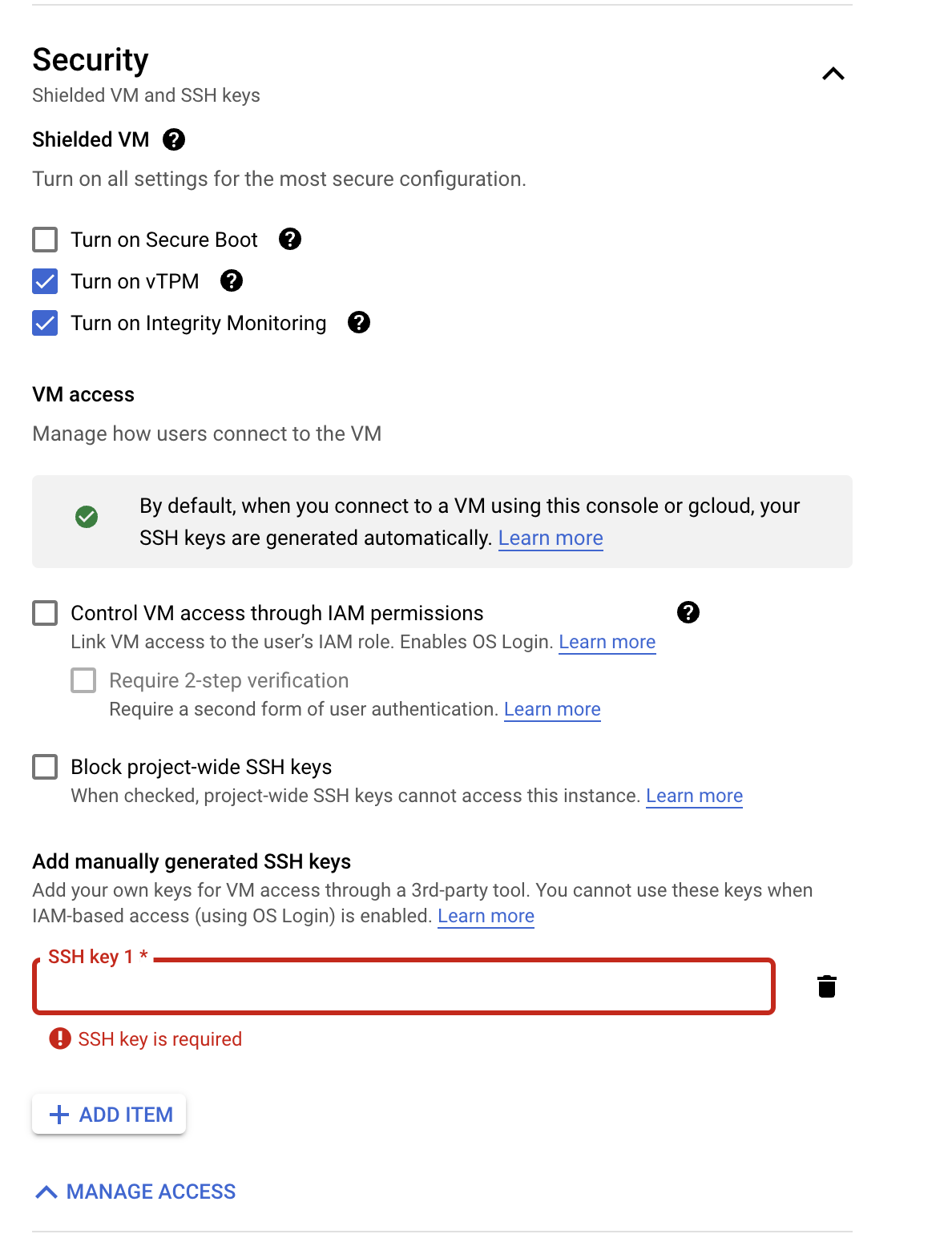
On the Create Instance page, click Create.
Set up Additional Software on the VM
After you create an instance, it is necessary to install additional required software packages and tools.
Open an SSH session to connect to your VM instance. You will need your private key and the IP address of the instance.


Use the commands to install the required packages for your operating system version:
RedHat 7
# install packages sudo yum update -y sudo yum install -y jq rsync screen curl openssl gawk ntp ntpstat # enable NTP sudo systemctl start ntpd sudo systemctl enable ntpd # install docker sudo yum install -y yum-utils sudo yum-config-manager \ --add-repo \ https://download.docker.com/linux/centos/docker-ce.repo sudo yum install -y docker-ce docker-ce-cli containerd.io docker-compose # NGSC v1.10+ will also require docker-compose-plugin sudo yum install -y docker-compose-plugin sudo systemctl start docker sudo systemctl enable docker # verify that the docker is installed correctly sudo docker run hello-world # install tmux curl --silent https://storage.googleapis.com/ngsc_update/exa-cloud-prod/tmux_install.sh | sudo bashRedHat 8 and 9
# install packages sudo dnf install https://dl.fedoraproject.org/pub/epel/epel-release-latest-8.noarch.rpm sudo dnf install 'dnf-command(upgrade)' sudo yum update -y sudo yum install -y jq rsync screen curl openssl gawk sudo yum install -y chrony # install docker sudo yum install -y yum-utils sudo yum-config-manager \ --add-repo \ https://download.docker.com/linux/centos/docker-ce.repo sudo yum install -y docker-ce docker-ce-cli containerd.io # NGSC v1.10+ will also require docker-compose-plugin sudo yum install -y docker-compose-plugin sudo systemctl start docker sudo systemctl enable docker # verify that the docker is installed correctly sudo docker run hello-world # install docker-compose sudo curl -L "https://github.com/docker/compose/releases/download/1.23.2/docker-compose-$(uname -s)-$(uname -m)" -o /usr/bin/docker-compose sudo chmod +x /usr/bin/docker-compose # verify that the docker-compose is installed correctly docker-compose -v # install tmux curl --silent https://storage.googleapis.com/ngsc_update/exa-cloud-prod/tmux_install.sh | sudo bashInstall additional packages required to run Site Collector:
Use the following commands to install required packages such as
docker,jq,rsync,screen,curl, andopenssl(for the full list, see prerequisites). You must ensure the packages you install meet the minimum version requirements, if specified.# install package sudo apt-get update sudo apt-get install -y ca-certificates curl gnupg lsb-release jq rsync screen curl openssl gawk ntp ntpstat # enable NTP sudo systemctl start ntp sudo systemctl enable ntp # install docker curl -fsSL https://download.docker.com/linux/ubuntu/gpg | sudo gpg --dearmor -o /usr/share/keyrings/docker-archive-keyring.gpg echo \ "deb [arch=$(dpkg --print-architecture) signed-by=/usr/share/keyrings/docker-archive-keyring.gpg] https://download.docker.com/linux/ubuntu \ $(lsb_release -cs) stable" | sudo tee /etc/apt/sources.list.d/docker.list > /dev/null sudo apt-get update sudo apt-get install -y docker-ce docker-ce-cli containerd.io docker-compose sudo systemctl start docker sudo systemctl enable docker # for docker-compose sudo curl -L "https://github.com/docker/compose/releases/download/1.23.2/docker-compose-$(uname -s)-$(uname -m)" -o /usr/local/bin/docker-compose sudo chmod 755 /usr/local/bin/docker-compose sudo ln -s /usr/local/bin/docker-compose /usr/bin/docker-compose # verify that the docker is installed correctly sudo docker run hello-world
Check the disk names by running the following commands.
[exabeam@ngsc-oncar-1 ~]$ lsblk NAME MAJ:MIN RM SIZE RO TYPE MOUNTPOINT sda 8:0 0 80G 0 disk ├─sda1 8:1 0 200M 0 part /boot/efi └─sda2 8:2 0 79.8G 0 part / sdb 8:16 0 200G 0 disk sdc 8:32 0 50G 0 disk sdd 8:48 0 25G 0 disk
Create partitions by running the following commands.
sudo parted -s /dev/sdb mktable gpt sudo parted -s /dev/sdc mktable gpt sudo parted -s /dev/sdd mktable gpt sudo parted -s /dev/sdb mkpart ext4 1MiB 100% sudo parted -s /dev/sdc mkpart ext4 1MiB 100% sudo parted -s /dev/sdd mkpart ext4 1MiB 100%
Create the file system by running the following commands.
sudo mkfs.ext4 /dev/sdb1 sudo mkfs.ext4 /dev/sdc1 sudo mkfs.ext4 /dev/sdd1
Create mount directories for NiFi and mount partitions according to the disk size specified in the prerequisites.
Use the following commands to create the folders and mount the disks to them:
sudo mkdir /content_repository sudo mkdir /provenance_repository sudo mkdir /flowfile_repository
sudo mount /dev/sdc1 /content_repository sudo mount /dev/sdd1 /provenance_repository sudo mount /dev/sdb1 /flowfile_repository
Following is the df output example.
[exabeam@ngsc-oncar-kanitkar-1 ~]$ df -h Filesystem Size Used Avail Use% Mounted on devtmpfs 7.8G 0 7.8G 0% /dev tmpfs 7.8G 0 7.8G 0% /dev/shm tmpfs 7.8G 8.5M 7.8G 1% /run tmpfs 7.8G 0 7.8G 0% /sys/fs/cgroup /dev/sda2 80G 3.1G 77G 4% / /dev/sda1 200M 12M 189M 6% /boot/efi tmpfs 1.6G 0 1.6G 0% /run/user/1000 tmpfs 1.6G 0 1.6G 0% /run/user/0 /dev/sdb1 197G 61M 187G 1% /content_repository /dev/sdc1 50G 53M 47G 1% /provenance_repository /dev/sdd1 25G 45M 24G 1% /flowfile_repository
Note
The size for sdd1 is less than 200G because the file system reserves some space for its requirements.
Set up auto mount for your drivers.
Check mounted drivers' IDs with the
ls -lha /dev/disk/by-uuidcommand as follows.[exabeam@ngsc-oncar-1 ~]$ ls -lha /dev/disk/by-uuid total 0 drwxr-xr-x. 2 root root 140 Sep 8 19:07 . drwxr-xr-x. 8 root root 160 Sep 8 18:41 .. lrwxrwxrwx. 1 root root 10 Sep 8 18:42 0308-0EB7 -> ../../sda1 lrwxrwxrwx. 1 root root 10 Sep 8 19:07 2ef7c5ee-4e95-4c5d-b254-70874ac5626e -> ../../sdc1 lrwxrwxrwx. 1 root root 10 Sep 8 18:42 34e26dc7-0242-4153-9621-9e70eaac573d -> ../../sda2 lrwxrwxrwx. 1 root root 10 Sep 8 19:07 7fb561d7-0781-492d-aeec-d3e0f6f84b35 -> ../../sdd1 lrwxrwxrwx. 1 root root 10 Sep 8 19:07 bb625665-ddfd-423f-8878-ec91169b95ae -> ../../sdb1
Edit your
/etc/fstabfile to add the three drivers that are linked to the repository folders. For example:/content_repositoryfolder in on/dev/sdb1disk. Disk ID =bb625665-ddfd-423f-8878-ec91169b95ae. In /etc/fstab set:UUID=a77fe15d-5039-49d7-a101-cabecc3b76f5 /content_repository ext4 defaults 0 2
/provenance_repositoryfolder in on/dev/sdc1disk. Disk ID =2ef7c5ee-4e95-4c5d-b254-70874ac5626e. In /etc/fstab set:UUID=bf10a05c-3932-4990-9140-a529684b6e2f /provenance_repository ext4 defaults 0 2
/flowfile_repositoryfolder in on/dev/sdd1disk. Disk ID =7fb561d7-0781-492d-aeec-d3e0f6f84b35. In /etc/fstab set:UUID=e322d567-6274-446c-a1e9-169ac6d47d45 /flowfile_repository ext4 defaults 0 2
The following screenshot shows an example of the FSTAB file.

Restart the server.
Verify that the VM instances is ready for Site Collector installation.
Run the following Site Collector pre-check script to validate the system.
curl -o ngsccli https://storage.googleapis.com/ngsc_update/exa-cloud-prod/exa-ngsc/ngsccli
The following message indicates that the instance is not ready and pre-checks failed.
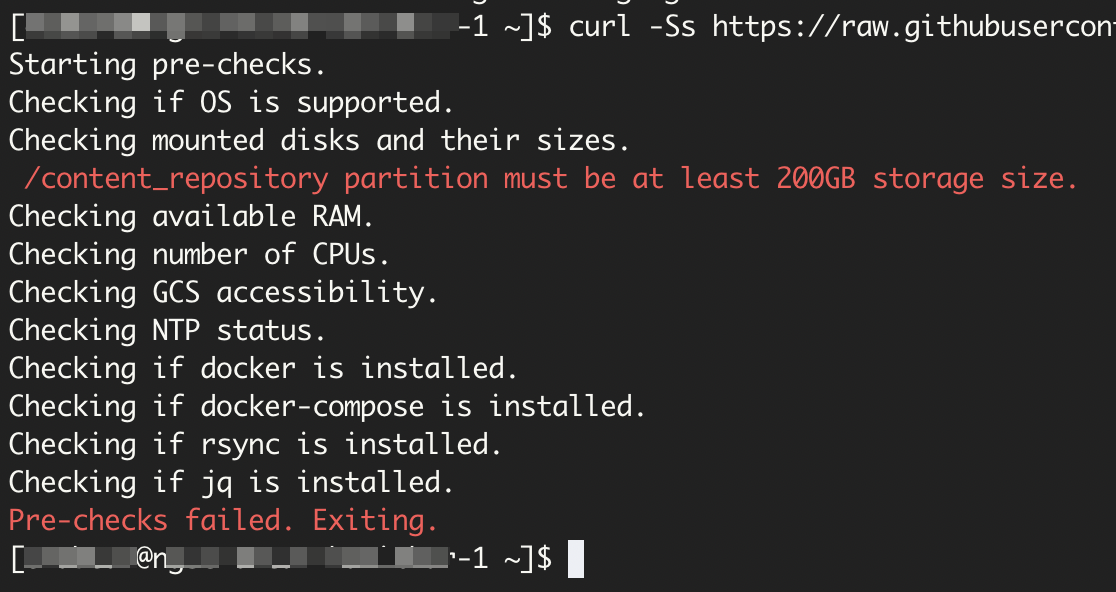
The following result indicates that the pre-checks and configuration are successful and the VM is ready for Site Collector installation.
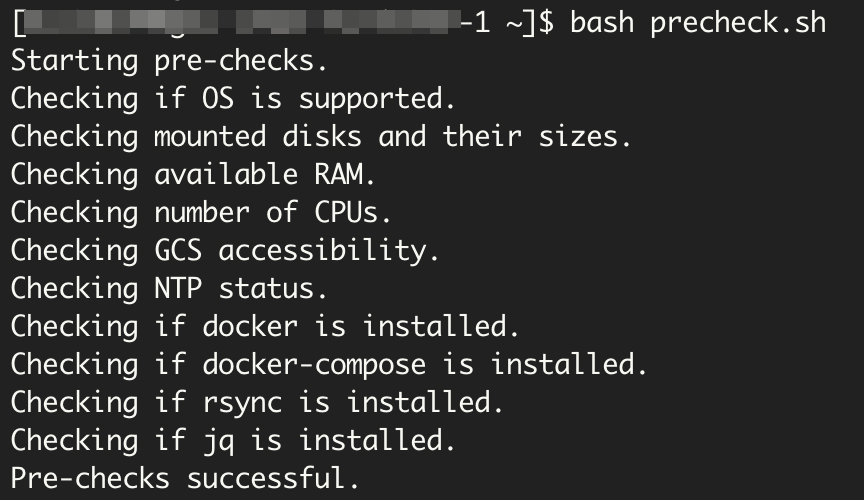
Install tmux on Centos or RHEL7
Site Collector must have tmux installed with a minimum 1.9 version. Centos or RHEL7 default yum installs tmux 1.8. Refer to the following method with steps to install a newer version of tmux.
sudo yum install -y gcc kernel-devel make ncurses-devel wget # DOWNLOAD SOURCES FOR LIBEVENT AND MAKE AND INSTALL wget https://github.com/downloads/libevent/libevent/libevent-2.0.21-stable.tar.gz tar -xvzf libevent-2.0.21-stable.tar.gz cd libevent-2.0.21-stable ./configure --prefix=/usr/local make sudo make install cd # DOWNLOAD SOURCES FOR TMUX AND MAKE AND INSTALL wget https://github.com/tmux/tmux/releases/download/1.9/tmux-1.9.tar.gz tar -xvzf tmux-1.9.tar.gz cd tmux-1.9 LDFLAGS="-L/usr/local/lib -Wl,-rpath=/usr/local/lib" ./configure --prefix=/usr/local make sudo make install sudo cp /usr/local/bin/tmux /bin/tmux